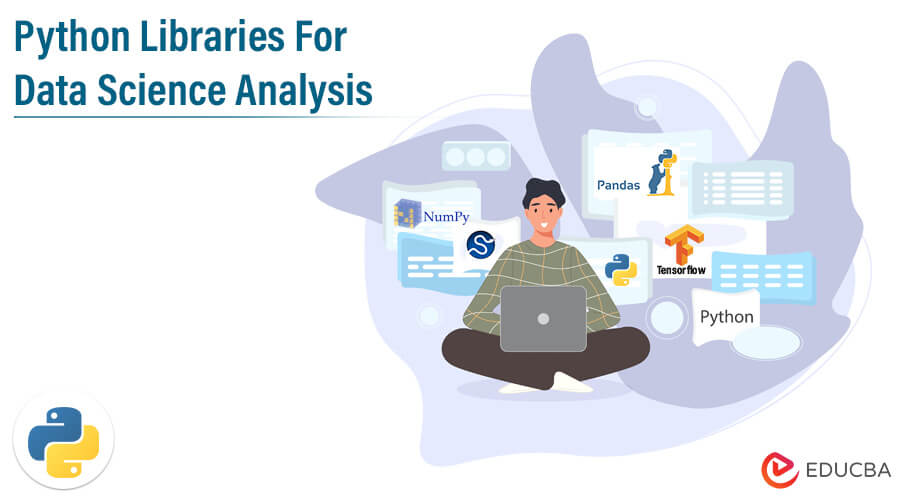Updated September 29, 2023
Python Libraries for Data Science
Various libraries incorporated pythons, such as TensorFlow, Theano, PyTorch, ApacheSpark, OpenCV, NetworkX, Shogun, Matplotlib, etc., leveraging data mining operations over data through various machine learning and deep learning algorithms. Finally, derived are termed Python Libraries for Data Science to facilitate the best possible insights from data and facilitate the right decision-making based on statistical and visual insights.
Best Python Data Science Libraries 2023
Based on the operations, we divide Python data science libraries into the following areas.
1. General Libraries
a. NumPy: NumPy stands for Numerical Python. It is one of the fundamental libraries for scientific and mathematical computations. For example, it helps us with efficient N-dimensional array operations, integrating C/C++ and Fortran codes, complex mathematical transformations involving linear algebra, Fourier transform, etc.
b. Pandas: It is the most popular library for reading, manipulating, and preparing data. Pandas provide highly efficient, easy-to-use data structures that help manipulate data between in-memory and external data formats like CSV, JSON, Microsoft Excel, SQL, etc.
Key features of this library are:
- Comes with a fast and efficient DataFrame object.
- High-performance merging and intelligent indexing of datasets.
- Low latency implementation is written in Cython and C etc.
c. SciPy: SciPy is another popular open-source library for mathematical and statistical operations. The core data structure of scipy is NumPy arrays. It helps data scientists and developers with linear algebra, domain transformations, statistical analysis, etc.
2. Data Visualization
a. Matplotlib: It is a 2D plotting library for visualization inspired by MATLAB. Matplotlib provides high-quality two-dimensional figures like bar charts, distribution plots, histograms, scatterplots, etc., with few code lines. Like MATLAB, it also gives users the flexibility of choosing low-level functionalities like line styles, font properties, axes properties, etc., via an object-oriented interface or a set of functions.
b. Seaborn: Seaborn is basically a high-level API built on top of Matplotlib. It comes with a visual reacher and informative statistical graphics like heatmap, count plot, violinplot, etc.
c. Plotly: Plotly is another popular open-source Python graphing library for high-quality, interactive visualization. In addition to 2D graphs, it also supports 3D plotting. Plotly is used extensively for in-browser visualization of data.
3. Machine Learning and NLP
a. ScikitLearn: ScikitLearn is probably one of the most widely used Python libraries for machine learning and predictive analysis. It offers an extensive collection of efficient algorithms for classification, regression, clustering, model tuning, data preprocessing, and dimensionality reduction tasks. It is built on top of NumPy, SciPy, and Matplotlib; hence it is easy to use, open-sourced, and reusable for various contexts.
b. LightGBM: In the later part of your data science learning, you will come across tree-based learning algorithms and ensembles. One of the most important methodologies in today’s machine learning is boosting. LightGBM is a popular open-source gradient boosting framework by Microsoft.
The key features of lightgbm are:
- Parallel and GPU-enabled execution.
- Fastness and better accuracy.
- The capability of handling large-scale data sets and supporting distributed computing.
c. Surprise: The recommendation system is an important area of interest for modern AI-based applications. State art Recommendation system enables businesses to provide highly personalized offerings to their clients. The surprise is a useful open-source Python library to build recommendation systems. It provides tools to evaluate, analyze, and compare the performance of the algorithm.
d. NLTK: NLTK stands for Natural Language Toolkit. It is an open-source library to works with human language data sets. It is handy for problems like text analytics, sentiment analysis, analyzing linguistic structure, etc.
4. Deep Learning
a. TensorFlow: TensorFlow is an open-source framework by Google to end machine learning and deep learning solutions. It gives low-level controls to the users to design and train highly scalable and complex neural networks. Tensorflow is available for both desktop and mobile and supports an extensive number of programming languages through wrappers.
b. Keras: Keras is an open-source high-level deep learning library. It gives the flexibility of using either TensorFlow or theano (another low-level Python library like TensorFlow) as a backend. In addition, Keras provides a simple high-level API for developing deep learning models.
It is suitable for quick prototyping and developing neural network models for industrial use. The primary usage of Keras is in classification, text generation, summarization, tagging, translation, speech recognition, etc.
5. Miscellaneous
a. OpenCV: OpenCV is a popular Python library for computer vision problems (Tasks involving image or video data). It is an efficient framework with cross-platform support and is ideal for real-time applications.
b. Dask: If you have low computation power or do not have access to large clusters, Dask is a perfect choice for scalable computation. Dask provides low-level APIs to build custom systems for in-house applications. So while working with a huge-scale dataset in your local box, you can opt for Dask instead of Pandas.
Conclusion
There is a rich set of Python libraries available for various data-driven operations in Python. This article discussed the most popular and widely used Python libraries across the data science community. Then, based on the problem statement and Organizational practices, appropriate Python libraries are chosen in practice.
Recommended Articles
This has been a guide to Python Libraries For Data Science. Here we have discussed the overview and different libraries of Python for data science. You can also go through our other suggested articles to learn more –


